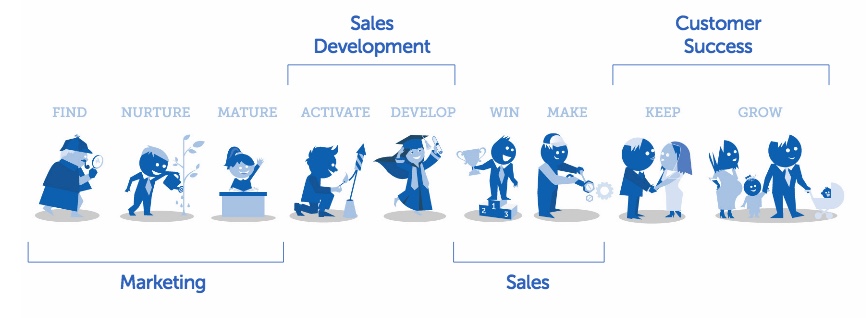Market Segmentation Fundamentals in the Software Industry – 4
This is the fourth and final post in the series about market segmentation fundamentals in the software industry. This time I will dive deeper into the practical aspects of testing your assumptions and scaling your lead generation efforts.
No matter how many yellow post-it notes you have filled and organised on a whiteboard and no matter how much desk research you have undertaken, the final test of your product/market-fit is how your potential customers react when you expose them to your value proposition.
I assume that your lead generation process requires outbound activities. The ideal readers for this series of posts are, therefore, revenue generation professionals in companies that cannot only fill their pipeline with inbound inquiries. That shouldn’t reduce the target audience much. Only very few companies in the B2B software industry can fill their pipeline only using an inbound approach.
The three-step validation process

There are two variables behind the term product/market fit:
- The choice of the market segment (the ideal customer profile or ICP)
- The definition of your product and its value proposition
By fine-tuning both, you can achieve better conversion rates, lower customer acquisition costs, faster growth, better gross margins and eventually better profits.
This post will present the three-step process that Stefan Avivson from BMoreRaw has developed. The beauty of his approach is that it removes the guesswork, can be used by any company, can be performed by almost anyone, and works when you subsequently want to scale your revenue generation efforts.
The three steps in the process are:

Step 1 – check internal assumptions
You ask your staff two questions:
- What characterises our ideal customers?
- Why do they buy our product?
You will most likely not get identical answers. Now is a good time for discussing and deciding as a company what the answers should be.

Step 2 – external verification
With your newly minted definitions, you check if your customers (if you have any) fit your ICP. And then you call those that do and ask them why they bought your product.
Most likely, the answers you get will not match your assumptions. With the data from your current customers, you go back and refine the two variables.
“Getting the market segmentation and the wording of the value proposition right takes a lot of effort,” says Stefan Avivson. “However, that is time well invested. Getting the two right has a significant impact on your customer acquisition cost.”
Step 3 – Refine and scale
With the revised version of your ideal customer profile, you can generate a list of potential customers and reach out.
“Generating a list of potential customers is a marketing job,“ says Stefan Avivson. “You don’t want the individual sales development reps to waste their time doing this. Using our approach, it also makes no sense whatsoever.”
Stefan recommends using a cold-call approach. Writing emails first is a waste of time. Leaving voicemails, though, can be effective (more about voicemails later).
According to the BMoreRaw approach, there are only a few questions in the call script (yes – the method is based on call scripts!).
“B2B software is not sold in a single phone call,” says Stefan Avivson. “The objective of the call is to verify interest and agree on a next step. Such a conversation shouldn’t take more than a few minutes. We are generating leads, not selling the product.”
The first question sounds like this:

Hi, my name is Hans Peter Bech from TBK Consult.
I sell a service that helps software companies expand internationally. Are you the person to talk to about this? (or if calling a gatekeeper: who should I talk to about this?)
If the answer is no, you ask who is and to be redirected if possible.
If the answer is yes, then you ask:
Are you interested to know more about a service that helps software companies expand internationally?
If the answer is no, then you ask why not?
You don’t want to convince the person. You only want to understand why she is not interested. You note the reasons, whatever they are, and say your goodbyes.
If the answer is yes, then you ask also why.
If the answer reveals a relevant and sincere interest matching what you are looking for, then you move to your call-to-action options.
“An unsolicited conversation should not take more than a few minutes,” says Stefan Avivson. “You are looking for a needle in the haystack, and you don’t want to waste your time on something that doesn’t have a high probability of becoming a needle. When you find a needle, then you agree on the next steps.”
Most sales development people forget that their job is to find potential customers who instantly recognise the value of what you offer. They are not doing you a favour by accepting to hear more or agree to a second call. You are doing them a favour. What many also forget is that this type of lead generation activity is a numbers game.
Cold-calling metrics
“Cold calling for lead generation purposes requires a certain structure,” says Stefan Avivson. “Typically, you book 90-minutes time slots in your calendar and start calling. If this is your main job, then you can have three to four such slots in a day.”

Stefan recommends using call centre software that presents the next contact and does the dialling for you. This way, you can make about 60 calls per slot. Most of the calls will be in vain since no-one is on the receiving end. Some will be with the wrong contact person, and some are not interested in talking to you. According to the BMoreRaw statistics, you should achieve, on average, three successful calls per time slot leading to the next step in the process.
“With an ultra-short value proposition, you can leave a voice mail,” says Stefan Avivson. “Some will call you back, and that’s fine. Until they do, they remain on the call list until they are disqualified.”
The BMoreRaw statistics across a multitude of projects show the following average metrics:
- Using call centre software, you can make sixty calls in ninety minutes.
- You will get through to twenty people.
- Each conversation takes two minutes.
- Seven are interested in learning more.
- Three will agree to the next step.
These results are only achievable if you invest in the product/market-fit exercise first.
A scientific approach that minimises the rejection rate
According to Stefan Avivson, almost anyone can follow the BMoreRaw system. He recommends using mature people to do sales development, but apart from adhering to the structured approach, no specific skills are required.

“Using our method, you deliberately look for rejection,” he says. “It’s perfectly all right that someone is not interested in the value proposition you present. All you do is present it, and if you can get a few additional words about the lack of interest, then that’s fine. Once in a while, someone is interested, and that is fine too. It’s all fine! As long as you learn why.”
He explains that if you, on average, get less than three leads out of a 90-minute call slot, then you need to revisit your basics. The problem can only be related to three areas:
- You are not making enough calls
- The quality of your list is too low
- The value proposition is unattractive
If you are making enough calls, then low performance is not a people issue.
“There are value propositions that are genuinely uninteresting”, says Stefan Avivson, “and there are also some that are very hard to explain. With such value propositions, you cannot generate leads using cold calling. The rejection rate becomes too high.”
Don’t waste time preparing the individual call

“It’s easy to see why spending ten minutes researching each contact you are about to call won’t work,” says Stefan Avivson. “It reduces the number of calls from 50 to 9. The chance that you will spend 90 minutes getting no one on the line is very high. And what are you going to use that information for anyway?”
He again stresses that you are not supposed to argue with the person on the other end of the line. You are looking for a fast no, so you can get on and find someone with a sincere yes.
Previous posts in this series:








